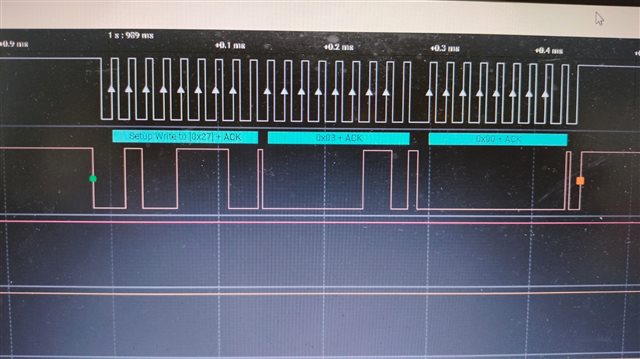主题中讨论的其他器件:TM4C1294NCPDT、
无法使用 I2C4从微控制器 TM4C1294ncpdt 驱动 IO 扩展器 TCA9534PWR。 我已初始化 I2C4、并尝试将 IO 扩展器 TCA9534配置为输出。 但以某种方式成功配置了芯片。 以下是 I2C 配置的快照(地址0x27、CONFIG 寄存器0x03并为所有输出写入数据值0x00)。 
随后是我在当前项目中用于驱动 IO 扩展器的源代码。 void I2C_init(){//############ 初始化############################ //在使用之前必须启用 I2C3外设。 SysCtlPeripheralEnable (SYSCTL_Periph_I2C3);SysCtlPeripheralReset (SYSCTL_Periph_I2C3);// I2C4外设在使用前必须被启用。 SysCtlPeripheralEnable (SYSCTL_Periph_I2C4);SysCtlPeripheralReset (SYSCTL_Periph_I2C4);SysCtlPeripheralEnable (SYSCTL_Periph_GPIOK);GPIOPinConfigure (GPIO_PK4_I2C3SCL);GPIOPinConfigure (GPIO_PK5_I2SDA); GPIOPinTypeI2CSCL (GPIO_PORTK_BASE、GPIO_PIN_4);GPIOPinTypeI2C (GPIO_PORTK_BASE、GPIO_PIN_5);I2CMasterInitExpClk (I2C3_base、 G_ui32SysClock、false);// I2CMasterSlaveAddrSet (I2C3_base、slave_address、false); //从地址到0x20 I2CMasterEnable (I2C3_BASE);GPIOPinConfigure (GPIO_PK6_I2C4SCL);GPIOPinConfigure (GPIO_PK7_I2C4SDA);GPIOPinTypeI2CSCL (GPIO_PORTK_BASE、GPIO_PIN_6); GPIOPinTypeI2C (GPIO_PORTK_BASE、GPIO_PIN_7);I2CMasterInitExpClk (I2C4_BASE、g_ui32SysClock、false); I2CMasterSlaveAddrSet (I2C4_base、0x27、false);//从器件地址更改为0x27 I2CMasterEnable (I2C4_base);I2CMasterGlitchFilterConfigSet (I2C3_base、I2C_MASTER_glitch_FILTER_2);I2CMasterGlitchConfigSet (I2C4_base、I2C_MASTER_FILTER_2);I2CMaster_FILTER_FILTER_2) void I2CSend4 (uint8_t slave_addr、uint8_t num_of_args、...) {uint8_t i =0;//告诉主模块在与从模块进行通信时将在总线上放置的地址// I2CMasterSlaveAddrSet (I2C4_BASE、slave_addr、false);//存储可变数量参数 va_list vargs 的列表;//指定 va_list 为"open",最后一个固定参数//so vargs 知道从何处开始查找 va_start (vargs、num_of_args);//将数据放入 FIFO (iint2c4)中(iint_vargs、uart_data_vargs); //如果只有一个参数,我们只需要使用//单个 send I2C 函数 if (num_of_args == 1){//发起从 MCU I2CMasterControl (I2C4_base、I2C_MASTER_CMD_SINGLE_SEND)发送数据;//等待 MCU 完成传输。 while (I2CMasterBusy (I2C4_base);//"关闭"变量参数列表 va_end (vargs);}//否则,我们在//I2C 总线上开始传输多个字节 else{//启动从 MCU I2CMasterControl (I2C4_base、I2C_MASTER_CMD_BURST_SEND_START)发送数据;//直到 MCU 完成传输。 while (I2CMasterBusy (I2C4_base));//发送 num_of_args-2段数据、使用 I2C 模块的//burst_send_cont 命令执行以下操作(i = 1;i <(num_of_args - 1);i++){//将下一段数据放入 I2C FIFO I2sture_send_cont (iCM2ster_dataPut)、i2c4 (iCM_base_arg_1)、I2c4 (i2c4)、直接发送到 I2c4 (iCM_base_c4); //等待 MCU 完成传输。 while (I2CMasterBusy (I2C4_base);}//将最后一段数据放入 I2C FIFO I2CMasterDataPutt (I2C4_base、va_arg (vargs、uint32_t));//发送刚刚放入 FIFO 的下一个数据 I2CMasterControl (I2C4_BASE、I2C_MASTER_CMD_WAITE_MCU);//发送完成之前)。 while (I2CMasterBusy (I2C4_BASE);//"close "变量 args list va_end (vargs);}//在从器件上读取指定的寄存器 uint32_t I2CReceive4 (uint32_t slave_addr、uint8_t reg){//指定我们正在将(寄存器地址)写入从器(eint32_t I2C4寄存器地址)、eSlaveAddr、///指定为从器、eSlaveAddr、e2I 地址);//指定从器; //将控制字节和寄存器地址字节发送到从器件 I2CMasterControl (I2C4_BASE、I2C_MASTER_CMD_BURST_SEND_START);//等待 MCU 完成事务 while (I2CMasterBusy (I2C4_BASE));//指定我们将从从从器件 I2CMSlavastereAddrSet (I2CMasterBusy (I2C4_BASE/STED/BEEDBACK)读取;//指定的控制/从 I2CMaster_BYTE、I2CD_BET_BIST_BEEDBY_FEEDBACK、I2CM_FAC_CONTROL_CASE); //等待 MCU 完成事务 while (I2CMasterBusy (I2C4_base));//返回从指定寄存器拉取的数据返回 I2CMasterDataGet (I2C4_base);}void set_output (){I2CSend4 (SLAVE_DR1、2、0x03、0x00);void Write_output (uint8_t pin、1、2、}0x01;}
